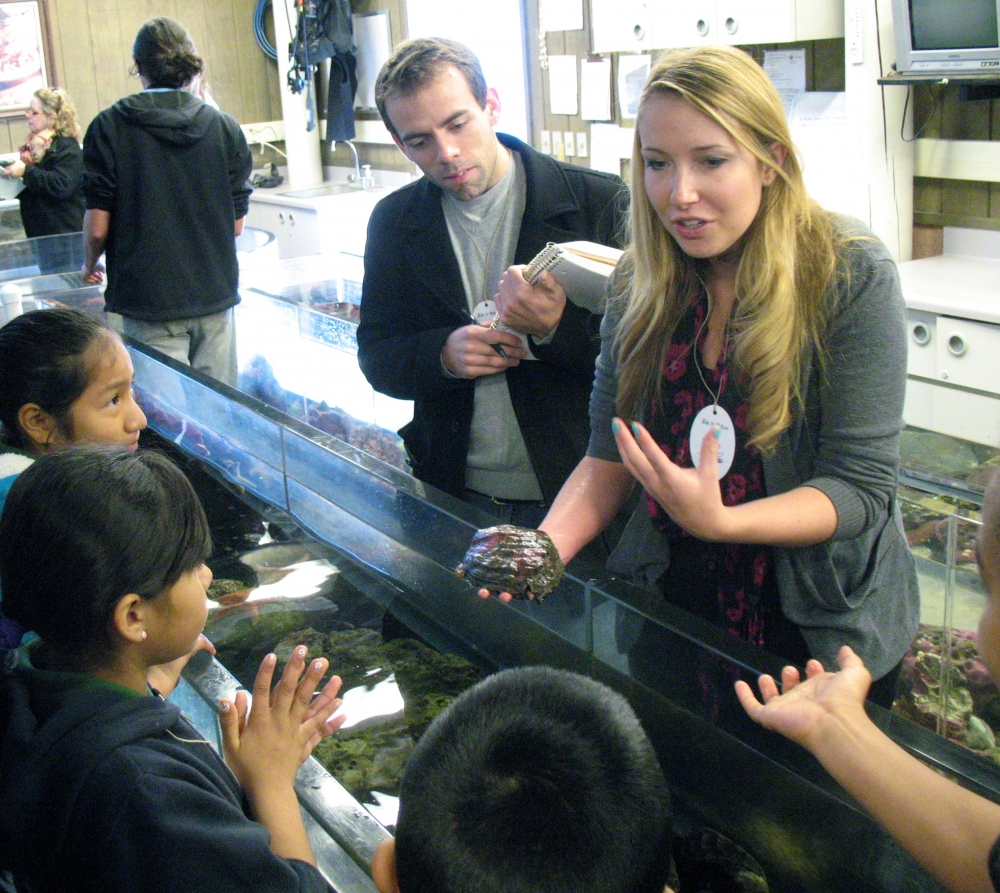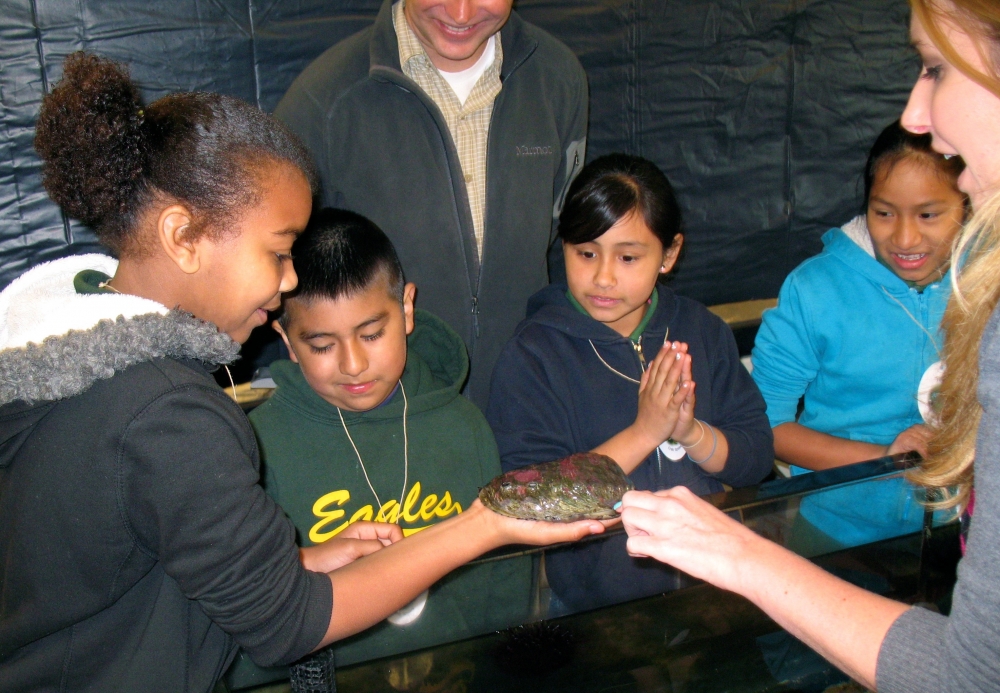Thank you so much for a lifetime experience. I never thought that I could be a scientist but you made it possible. … Sincerely, Catalina.
That thank-you note –– one of hundreds received from 10- and 11-year olds –– demonstrates how Kids in Nature, a program administered by UC Santa Barbara's Cheadle Center for Biodiversity & Ecological Restoration, is changing the lives of fifth-grade students in Santa Barbara.
Kids in Nature, or KIN, is an innovative, award-winning outreach program that helps children connect with the natural world, engaging the students in scientific and ecological experiences. A primary goal of the program is to help develop an educated population that is better able to make informed decisions about the future of the environment.
KIN also serves as a way to help UCSB students learn how to teach and mentor underrepresented and underserved schoolchildren in the program about science.
The children from Katie Booser's fifth-grade class at Franklin School could hardly contain their excitement during this week's field trip to the REEF (Research Experience and Education Facility) at UCSB. They were mesmerized by the sea creatures housed in over a dozen tanks designed for teaching. They held and touched sea stars, sea urchins, sea cucumbers, sea hares, snails, and even a shark.
Mac Wing, a biology student, is a KIN mentor and a docent at the REEF. "The swell shark puffs up with water when scared," said Wing, holding a small shark that he presented to the children. He explained that sharks do not have scales like most fish, and invited them to touch the skin. All eyes were on the swell shark as one brave child reached out to touch the animal. By touching its skin in one direction and then in another, she could feel that, indeed, this sea creature had no scales –– a lesson that she will remember better than anything she could read in a textbook.
Lindsey Bennett, an undergraduate teaching assistant and mentor to the children in KIN, talked about the transformation that she sees in the kids during the school year. "A lot of them come in with the idea that science is difficult or something that they may not be able to do –– that they can't be scientists, they can't learn science," said Bennett. "And when you see it click, you can just see it in their eyes, they light up. They're so excited when they understand a concept. I just love seeing that in any of the students."
"Most teachers do not have the time, or the resources, or the training to offer opportunities in environmental science education," said Jennifer Thorsch, program director, who also is the Katherine Esau Director of CCBER. "The children who are in the Kids In Nature program have the opportunity to go on seven different field trips during the year-long, place-based, hands-on program. It exposes them to the community that they live in and helps them understand the natural world –– and ultimately become better stewards of the environment."
After the touch tanks, the children went to the beach at Campus Point, where they learned about food webs. A KIN mentor drew two circles in the sand, one for "primary consumers," which includes sea urchins, and another for "producers," including kelp –– which ocean animals such as sea urchins eat. Meanwhile, fifth-grader Jose dragged a long piece of giant kelp, many times his height in length, along the beach, and pronounced it "fun."
Fun is integral to the learning process on these field trips. The children experience the environment with all of their senses, and that makes a powerful impression. "We never have behavior problems because the kids are so engaged," said Thorsch. She noted that special-needs children often blossom on the field trips, given the opportunity to experience so many ways of learning.
Creativity abounds in the ways that the KIN program reaches out to children. "Last quarter, a university student wrote a song about the parts of a flower, and taught it to the children as a way to remember," said Thorsch. "And not just parts, but function, too –– that's a fifth-grade standard: structure and function."
Each child receives a beautiful science notebook and nature journal filled with color illustrations and photographs of plants and animals. The book begins with a "passport," with slots for stickers from each field trip –– the REEF, Botanic Garden, Arroyo Hondo, CCBER, Coal Oil Point, Storke Wetlands, and for the activities in the native plant gardens at each school site. The students also create artwork, using leaves and dyes to decorate their KIN backpacks.
In addition to learning about food webs on the beach and visiting the touch tanks at the REEF, the children visit two other learning stations: the Magic Planet, an interactive digital globe that teaches about natural processes at the global scale, and the wetlands restoration laboratory. In the lab, the children have the opportunity to learn about water absorption in soil, sand, peat, and clay.
By the end of the year, teachers can measure students' progress in at least one traditional way: standardized test scores. "It varies from year to year, but we are always above average with our classes," said Thorsch.
The undergraduate and graduate students who get involved in teaching and mentoring the fifth-grade children are often profoundly influenced by the experience, according to Thorsch. Many of them turn toward teaching and environmental education as a result of the program. They get involved through Thorsch's UCSB classes, offered through environmental studies and biology programs and through the science and math minor offered by the Givertz Graduate School of Education.
Thorsch was pleased to report a $7,500 grant to KIN from Southern California Gas Company. She also acknowledged the Givertz Graduate School of Education and the Coastal Fund on campus, which help to support the program, including the paid internships. She mentioned that the ability to continue the program next year depends on continued funding.
† A docent at UCSB's REEF (Research Experience and Education Facility) teaches fifth-graders from Franklin Elementary School about marine animals.
Photo by George Foulsham, UCSB Office of Public Affairs and Communications
†† Middle image: Fifth-graders from Franklin Elementary School examine an abalone from a touch tank at UCSB's REEF (Research Experience and Education Facility).
Photo by George Foulsham, UCSB Office of Public Affairs and Communications
Related Links
Cheadle Center for Biodiversity & Ecological Restoration
Kids in Nature






